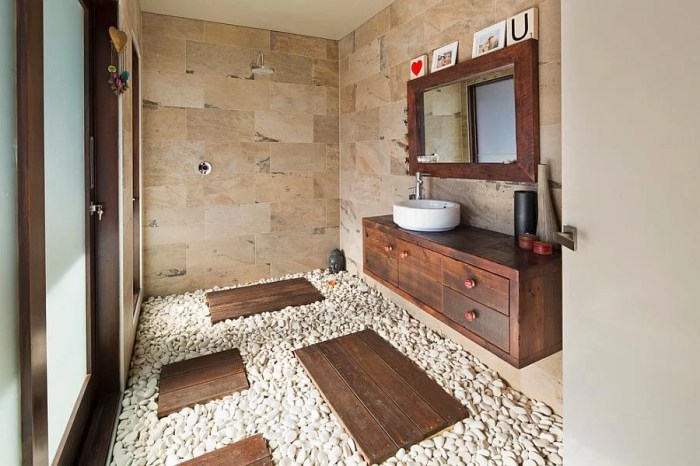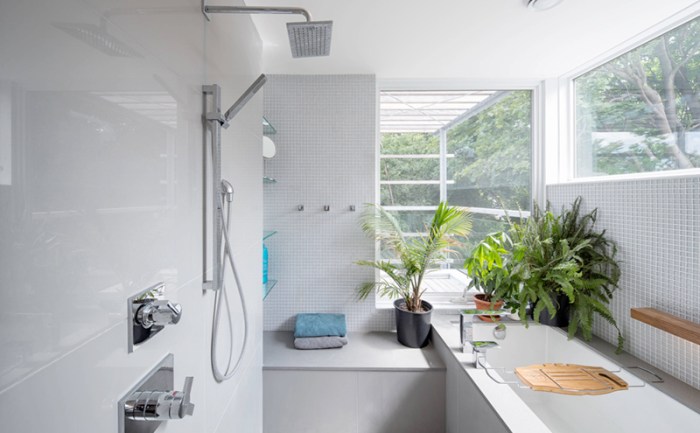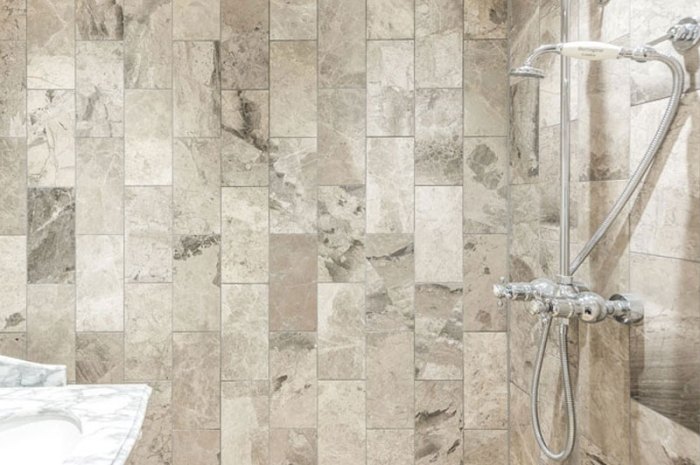Stepping into a bathroom should be a luxurious and relaxing experience. However, maintaining a pristine and functional bathroom can be challenging, especially when it comes to choosing the right tiles for wet environments. Non-porous stone tiles offer an exceptional solution, combining durability, aesthetics, and ease of maintenance to create the perfect bathroom oasis.
In this comprehensive guide, we will delve into the world of non-porous stone tiles, exploring their unique properties, the diverse range of options available, and the essential considerations for installation and maintenance. Whether you’re embarking on a bathroom renovation or simply seeking inspiration, this guide will provide you with all the information you need to make an informed decision.
Tile Material Properties
Non-porous stone tiles are an excellent choice for wet bathroom environments due to their unique characteristics.
These tiles are crafted from natural stone that has undergone a process called vitrification, which eliminates pores and voids within the material. As a result, non-porous stone tiles possess several advantages that make them ideal for bathrooms.
Advantages of Non-Porous Stone Tiles
- Impervious to Water: Unlike porous materials, non-porous stone tiles do not absorb water, preventing moisture penetration and potential damage to the subfloor.
- Stain Resistance: The lack of pores also makes these tiles highly resistant to stains, ensuring a clean and pristine appearance.
- Durable and Long-Lasting: Non-porous stone tiles are incredibly durable and can withstand the wear and tear of a busy bathroom environment.
- Hygienic: The non-porous surface inhibits the growth of mold and mildew, promoting a healthy and hygienic bathroom space.
Types of Non-Porous Stone Tiles
In the realm of wet bathroom environments, non-porous stone tiles reign supreme, offering an unparalleled combination of durability, slip resistance, and aesthetic appeal. These tiles are crafted from natural stone that has undergone a specialized treatment to seal its pores, rendering them impervious to moisture absorption.
The diverse range of non-porous stone tiles available caters to a wide spectrum of design preferences and performance requirements. Each type possesses unique characteristics that make it suitable for specific applications.
Granite
- Granite is renowned for its exceptional durability, making it an ideal choice for high-traffic areas. Its dense structure resists scratches, chips, and stains, ensuring a pristine appearance for years to come.
- The inherent slip resistance of granite provides a secure footing in wet environments, minimizing the risk of accidents.
- Granite’s aesthetic versatility allows it to complement a variety of design styles, from classic to contemporary.
Marble
- Marble exudes an aura of timeless elegance and luxury. Its smooth, polished surface creates a sophisticated ambiance that enhances any bathroom space.
- While marble is not as durable as granite, its inherent slip resistance makes it a suitable choice for wet areas. However, regular sealing is recommended to maintain its pristine condition.
- Marble’s natural veining and color variations add a touch of individuality and character to any bathroom design.
Slate
- Slate is a highly durable and versatile stone that is often used in outdoor applications. Its textured surface provides excellent slip resistance, making it a safe choice for wet bathrooms.
- Slate’s natural cleft finish adds a rustic charm to any bathroom design. It is also available in a honed or polished finish for a more refined look.
- Slate’s inherent water resistance makes it an ideal choice for showers and other areas that are frequently exposed to moisture.
Travertine
- Travertine is a porous stone that has been filled and sealed to enhance its moisture resistance. It is known for its warm, earthy tones and unique veining patterns.
- Travertine’s slip resistance makes it a suitable choice for wet bathroom environments, although it may require more frequent sealing than other non-porous stone tiles.
- Travertine’s natural beauty and versatility make it a popular choice for both classic and modern bathroom designs.
Installation Considerations
Installing non-porous stone tiles in wet bathroom environments requires careful attention to detail to ensure a durable and aesthetically pleasing result. Proper substrate preparation, waterproofing, and grouting techniques are essential for a successful installation.
Substrate Preparation
The substrate, which is the surface on which the tiles will be installed, must be smooth, level, and free of any debris or imperfections. Any unevenness or imperfections can lead to uneven tile placement and compromised waterproofing. It is recommended to use a leveling compound or backer board to create a smooth and even surface before installing the tiles.
Waterproofing
Waterproofing is crucial in wet bathroom environments to prevent water damage to the substrate and surrounding areas. A waterproof membrane should be applied to the substrate before installing the tiles. This membrane creates a barrier that prevents water from seeping through the tiles and grout joints.
Grouting
Grouting is the process of filling the spaces between the tiles. It is important to use a grout that is specifically designed for wet environments, such as epoxy grout or urethane grout. These grouts are resistant to water and mildew, which helps to prevent the grout from deteriorating over time.
Avoiding Common Pitfalls
*
-*Improper Substrate Preparation
Failing to properly prepare the substrate can lead to uneven tile placement, compromised waterproofing, and reduced durability.
-
-*Insufficient Waterproofing
Inadequate waterproofing can allow water to penetrate the substrate, leading to damage and potential mold growth.
-*Using the Wrong Grout
Using a grout that is not designed for wet environments can result in grout deterioration and compromised waterproofing.
-*Overgrouting
Applying too much grout can make it difficult to clean and can trap moisture, creating a breeding ground for bacteria.
-*Uneven Grout Joints
Uneven grout joints can detract from the aesthetic appeal of the installation and can compromise waterproofing.
Maintenance and Care

Non-porous stone tiles in wet bathroom environments require proper maintenance to preserve their beauty and durability.
Regular cleaning, sealing, and protection are essential to prevent damage and ensure longevity.
Cleaning
* Clean tiles regularly with a mild, non-abrasive cleaner specifically designed for stone surfaces.
- Avoid using harsh chemicals, abrasive cleaners, or acidic solutions, as they can damage the tile’s finish.
- Use a soft cloth or sponge to wipe away dirt and debris. Avoid using steel wool or abrasive pads, which can scratch the surface.
Sealing
* Seal tiles every 1-2 years to protect them from moisture, stains, and wear.
- Use a penetrating sealer that penetrates the tile’s pores and creates a protective barrier.
- Follow the manufacturer’s instructions for application and drying time.
Protection
* Place mats or rugs on the floor to protect tiles from scratches and wear.
- Avoid using harsh chemicals or cleaners on grout lines, as they can damage the grout and allow moisture to penetrate.
- Regularly inspect tiles for cracks or chips and repair them promptly to prevent further damage.
Design and Aesthetics
Non-porous stone tiles offer a wide range of design possibilities, allowing you to create stunning and sophisticated bathroom spaces. These tiles come in a variety of colors, patterns, and textures, providing endless opportunities for customization.
When choosing non-porous stone tiles for your bathroom, consider the overall style you want to achieve. For a classic and elegant look, opt for neutral colors such as white, beige, or gray. These colors will create a timeless and sophisticated ambiance.
If you prefer a more modern and contemporary style, consider bolder colors such as black, navy, or emerald green. These colors will add a touch of drama and sophistication to your bathroom.
Color
The color of your non-porous stone tiles will have a significant impact on the overall look and feel of your bathroom. Neutral colors, such as white, beige, and gray, are versatile and can be paired with a variety of other colors and materials.
Bold colors, such as black, navy, and emerald green, can create a more dramatic and sophisticated look.
Pattern
The pattern of your non-porous stone tiles can add visual interest and depth to your bathroom. Common patterns include subway tiles, herringbone tiles, and mosaic tiles. Subway tiles are a classic choice that can be used to create a variety of looks, from traditional to modern.
Herringbone tiles are a more unique and eye-catching option that can add a touch of sophistication to your bathroom. Mosaic tiles are a great way to add color and pattern to your bathroom. They can be used to create a variety of designs, from simple borders to complex murals.
Texture
The texture of your non-porous stone tiles can add a touch of luxury and sophistication to your bathroom. Honed tiles have a smooth, matte finish that is soft to the touch. Polished tiles have a glossy finish that reflects light and creates a more glamorous look.
Tumbled tiles have a slightly rougher finish that gives them a more rustic appearance.
Final Conclusion
In conclusion, non-porous stone tiles are an exceptional choice for wet bathroom environments. Their durability, low maintenance, and stunning aesthetics make them a worthwhile investment for any homeowner seeking to create a luxurious and functional bathroom space. By carefully considering the type of tile, installation techniques, and maintenance practices, you can ensure that your bathroom remains a sanctuary of relaxation and beauty for years to come.


